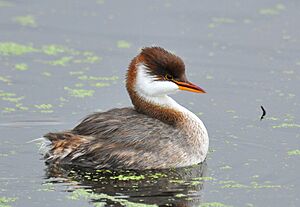Titicaca grebe facts for kids
Quick facts for kids Titicaca grebe |
|
|---|---|
 |
|
| Conservation status | |
| Scientific classification | |
| Genus: |
Rollandia
|
| Species: |
microptera
|
 |
|
| Synonyms | |
The Titicaca grebe (Rollandia microptera) is a special type of water bird. It is also called the Titicaca flightless grebe or short-winged grebe. This bird lives on the high plains, known as the altiplano, in Peru and Bolivia.
Most of these grebes live on Lake Titicaca, which is a very large lake. They can also be found in other nearby lakes like Uru Uru and Poopó. Sometimes, in very wet years, they spread to smaller lakes connected to Lake Titicaca. Long ago, there were many more Titicaca grebes. They used to have large groups in lakes like Umayo and Arapa.
Contents
What Does the Titicaca Grebe Look Like?
This grebe is a medium-sized bird. It can be from 28 to 45 centimeters (about 11 to 18 inches) long. It weighs up to 600 grams (about 1.3 pounds). Its colors are easy to spot.
The Titicaca grebe has a dark belly. It has a white patch on its throat that goes down its neck. Its sides are a reddish-brown color, which you can often see because its wings are short. The feathers on its head are dark and decorative. Its eyes and the bottom part of its beak are yellow.
Young grebes and adults not in breeding season look a bit duller. They do not have the fancy head feathers. Young birds also have reddish-brown stripes on the sides of their heads.
This bird cannot fly at all. But it is very good at running on the water, using its small wings to help. It is also an excellent diver. It can swim underwater very fast, reaching speeds of about 3.5 kilometers per hour (2 knots).
Where Do Titicaca Grebes Live?
The Titicaca flightless grebe lives in shallow waters, usually up to 10 meters (35 feet) deep. They like areas with lots of reeds. These reeds, mostly called Totora, grow in water up to 4 meters (13 feet) deep. The reeds are where the grebes build their nests and raise their young.
Other plants in their habitat include underwater plants and floating plants like duckweed. Deeper parts of the lake have different underwater plants. Studies show that these grebes are very sensitive to changes in their environment.
What Do Titicaca Grebes Eat?
Like all grebes, the Titicaca grebe mainly eats fish. About 95% of their food is a type of small fish called Orestias pupfish. These fish live in the Lake Titicaca area.
They usually do not eat the larger, introduced fish called silversides (Odontesthes bonariensis). This is because the grebes only eat fish smaller than about 15 centimeters (6 inches). Adult silversides are much too big for them to eat.
Titicaca Grebe Life Cycle
It is thought that each pair of grebes tries to have young once a year. The parents likely take care of their young for a long time. There might not be a specific time of year when they breed.
Usually, a pair has 2 young birds, but sometimes they can have up to 4. Young birds probably become independent when they are a bit less than one year old. Even though more birds are seen nesting around December, about half of the adult grebes seem to be breeding or caring for young at any time.
Protecting the Titicaca Grebe
The Titicaca grebe is an Endangered species. This means it is at high risk of disappearing. There are fewer than 750 adult grebes left. In the past, there were thousands.
One of the biggest dangers to these birds is fishing nets. Many grebes drown in the thin fishing nets used by people. This problem became much worse in the 1990s. In 2003, it was estimated that over 2,500 grebes were alive, with possibly up to 1,500 adult birds. Even with this number, it is still a big drop from before the 1990s.
Dangers to the Grebe
Besides drowning in fishing nets, other dangers are usually smaller or happen only in certain places. Sometimes, people collect grebe eggs, but this is usually not a big problem. Adult grebes are not hunted because they taste like old fish.
Pollution and too many boats can make grebes leave an area. Also, if too many reeds are cut down, the birds might leave. However, the grebes have survived big changes in the past, like climate change. They seem to be able to recover from drops in their numbers. This helps them when their habitat changes, like when the lake floods or dries up.
The fishing for the larger silversides usually happens in deeper waters, where the grebes do not go. However, the nets used for smaller fish can still catch and drown young grebes. If fishermen catch more silversides instead of the smaller Orestias fish, it would help the grebes and the lake's ecosystem.


